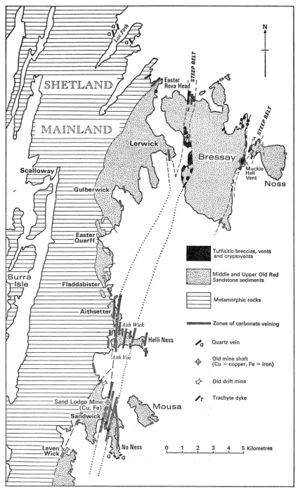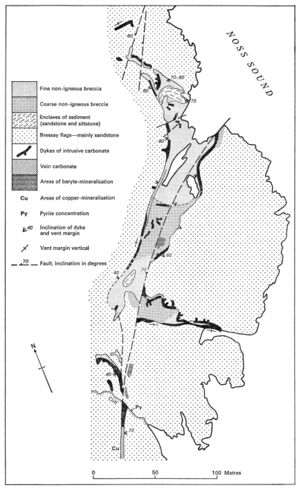Volcanic breccias and vents and associated mineralisation, Shetland
| Mykura, W. 1976. British regional geology: Orkney and Shetland. Edinburgh, Her Majesty's Stationery Office. |
Bressay and Noss


Two north—south trending belts of steeply inclined and locally inverted strata traverse the gently inclined Middle and ?Upper Old Red Sandstone strata of Bressay and Noss (P915591). The western ‘steep belt’ is up to 800 m wide and contains extensive irregular outcrops of breccia. The breccia consists of blocks of sediment of the type forming the surrounding non-brecciated areas, set in a matrix of finely comminuted sedimentary material of sand and silt grade. Individual blocks range in diameter from a few centimetres to tens of metres and some enclaves have a diameter of up to 200 m. Those less than 2 m in size are subangular to subrounded and randomly rotated. The larger blocks and enclaves usually retain their original orientation, though some are tilted, so that the bedding in them is now almost completely inverted. Some of the blocks are pierced by one or more generations of veinlets of intrusive tuffisite composed of fine sedimentary detritus, and a few contain cryptovents of intrusion-breccia.
The eastern steep belt, which traverses Noss, has no major breccia masses actually within it. Immediately west of it, however, there is a faulted syncline and this contains a large mass of sediment-breccia which forms the western peninsula of Noss and a dyke of altered ?aegirine-trachyte exposed along the north-west coast of the island. On the east side of Bressay, near the axial trace of the syncline, there are several breccia vents and one sill of intrusive tutlisite. One elongate fissure-vent exposed near Muckle Hell (P915592), on the east coast of Bressay, has dykes of flow-banded carbonate rock (containing up to 95 per cent carbonate, mainly ankerite and calcite, as well as small clasts of sediment) intruded along its margins. These dykes also cut the vent breccia and the adjoining country rock. Their origin is not certain; they may have formed as intrusive tuffisite which has been largely replaced by carbonate, or they may be the product of a viscous carbonate magma. The latter origin is more likely. The breccias and associated sediments of both steep belts contain veins of crystalline carbonate and quartz with small quantities of iron and copper sulphides.
The two steep belts form the near-vertical limbs of monoclines in the sedimentary cover of this area, and they probably refleet the presence of north-south trending fracture belts in the metamorphic basement. Volcanic gases, carbonate-rich aqueous solutions and some magma appear to have passed upwards from the fracture belts into the sediment. In the western steep belt the gases penetrated along irregular cracks in the already shattered sedimentary rock and, by a process of gas-fluxion rather than explosion, they produced the large irregular areas of breccia. There appears to have been no significant upward or downward movement of solid material within the breccia. The eastern, westward sloping, steep belt did not appear to act as a funnel for escaping gases in the same way. Here the gases seem to have escaped directly upwards from the fissure into relatively unbroken rock and so gave rise to well-defined vents, dykes and sills. Most of the vents probably did not reach the surface.
South-east Shetland
The western steep belt of Bressay can be projected southwards to connect with a 500 to 1200 in-wide belt of intensive faulting and carbonate mineralisation which crosses the Helli Ness and Sandwick peninsulas of south-east Mainland (P915591). This belt contains several thick dyke-like masses of carbonate, extensive areas of carbonate net-veining, some narrow and irregular zones of tufiisitic breccia and one fault-bounded horst of the metamorphic basement. The carbonate veins within and close to this belt are in some cases the gangue of ore minerals which include pyrite, hematite, chalcopyrite, malachite, gersdorflite and niccolite. Copper and iron ores have, in the past, been commercially exploited at Sand Lodge and Setter mines. At Sand Lodge the strata in the shatter belt containing the veins have a monoclinal structure similar to that in west Bressay. Carbonate veins with traces of ore minerals are found all along the east coast of Mainland between Nesting and Levenwick, and the presence of similar veins in Fair Isle suggests that mineralisation of this type continues well to the south of Shetland Mainland.
Chemical analysis has shown that the carbonate dyke and vein rocks do not contain the trace elements, such as rare earths and niobium, which are generally present in carbonatites. Instead they have high trace concentrations of arsenic, nickel, chromium and copper. It is thought most likely that the gases and carbonate-rich solutions responsible for the breccia and vein formation were generated by the contamination of a magma by limestone and magnesite within the metamorphic basement.